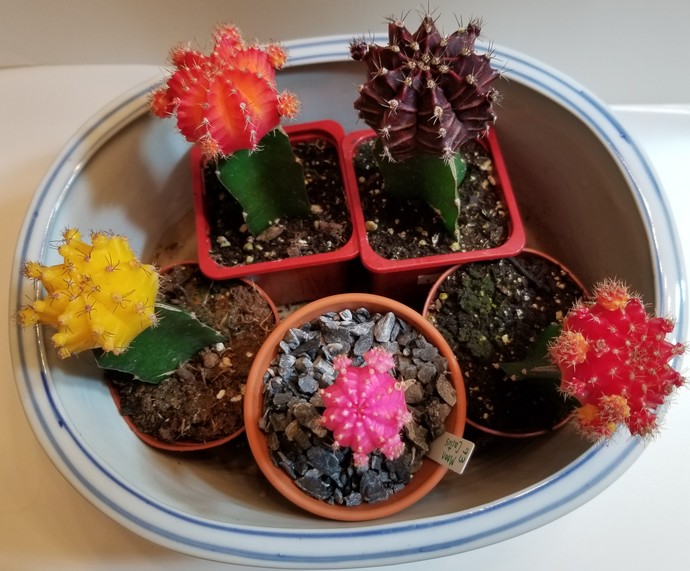For those of you wanting to learn more about how to care for those colorful, grafted cacti you find at Garden stores, you’ve come to the right place! They can live for many years with proper care!

A little history on Moon cactus or Lollipop cactus and info on them first.
Eiji Watanabe of Japan, a nurseryman, imported seeds of the Gymnocalycium mihanovichii cactus from Germany in 1937. Some of the seedlings he grew were mutants with reddish bodies that lacked chlorophyll and couldn’t survive on their own. He grafted the cactus (top part) onto green succulent stock (bottom) from the Dragonfruit plant (Hylocereus undatus) the colorful cactus survived and was able to live. Normally cactus are green and make their own food and grow roots. But these Variegated forms that were colorful lacked the resources to make plant food from the sun, thus why they needed grafting to a green plant to make food. Now how to care for them!
Lighting- Cactus need 8-12 hours of sun/light a day. I usually leave mine by a warm, sunny window indoors during the cooler months so they get natural sunlight that way. If you don’t have a warm window and you’re using a grow light, leave the light on 8-12 hours a day, then turn off. Cacti need a day/night cycle to grow properly. Be sure to rotate your plant pot a little each day so each side of the cactus gets light and it doesn’t bend to one side. If you are growing your cactus outside all day, put in a place where half the day it gets direct sun, and the other half it gets filtered sun or part shade. Be sure to rotate pot outside too for straight growth!
Pots- For my cactus I always use clay pots with drainage holes in the bottom so the water comes out. Cacti are prone to rot from overwatering, so drainage holes are a must! Clay pots absorb water where plastic doesn’t, so they are better for cactus. Place your cactus in a pot slightly larger than the roots size. Cacti can do ok in cramped pots.

Watering- I only water my cactus when the soil fully dries out. Overwatering will quickly rot a cactus. When the soil is fully dry, water the soil until water starts draining out of the holes then stop. It’s important to know that cacti only should be watered during the growing season, usually spring through early fall. For me in New York that is May-October. If your cactus is outside during the hot months natural rain is ok, as long as it’s not more than a day or two. Bring inside temporarily if you expect more than two days of rain to allow the soil to dry. Cacti require dormancy, so for me November-April when they are inside I do not water at all! They need this natural rest and will do fine with no water. You may notice the green part or colorful part get a little thinner, that’s ok as long as they aren’t turning brown or mushy.
Soil- For my cactus I buy pre bagged (cacti soil only!) at a garden center and add extra Perlite (looks like white styrofoam pieces). The perlite makes drainage of water quicker and so the soil doesn’t get compacted. You could add coarse sand, pumice, or shale pieces to cacti soil instead of perlite for drainage, but for me perlite is easiest to use. I repot my cactus ONCE a year and add all new soil for new nutrients.

Fertilizer- It’s better to under fertilize than over. Cacti soil you buy has fertilizers mixed in. Once a month during the growing season (for me May-October) I’ll add a diluted amount of Alaska fish emulsion as fertilizer mixed with water. Then I’ll water right after again to ensure it reaches the roots below. Stores also sell pre made cactus fertilizer with directions too if you find that easier.

Diseases- As I mentioned earlier these cactus are prone to rot from overwatering. If you find the green part turning yellow/brown and mushy you might have rot forming. Do not water for at least a month if you see this and keep it warm with plenty of light, sometimes they will pull through and heal. But if your entire plant gets mushy there is nothing you can do to save it.

Outdoor care- These cacti can be grown outdoors. The temperature must be no lower than 55F to be safe. If you live in plant hardiness zones 9,10, and 11 you can probably grow them outside all year and even try planting in the ground.
Flowering/seed pods- If you take very good care of your cactus you might see pretty flowers grow. If you are even luckier, months later those flowers turn to seed pods. You can harvest the pink seed pods with brown cactus seeds inside. I won’t get into growing from seed, goggle on how to grow cactus from seed.


Pups aka “baby cactus”- On the colorful body you might see smaller cactus growing all over. These are called “pups” or “offsets”. They are clones of the cactus. Businesses break these off to graft and make new plants as they will not grow roots to live on their own. I usually gently twist them until they break off and toss out so the main cactus body gets all the nutrients, but you can leave them on. Warning, as they grow they might make your cactus top heavy and you might need support or a plant stake to hold it up.

I hope this encourages you to adopt one of these little cuties and be the best Cactus Parents 🌵
 Holidays
Holidays  Girl's Behavior
Girl's Behavior  Guy's Behavior
Guy's Behavior  Flirting
Flirting  Dating
Dating  Relationships
Relationships  Fashion & Beauty
Fashion & Beauty  Health & Fitness
Health & Fitness  Marriage & Weddings
Marriage & Weddings  Shopping & Gifts
Shopping & Gifts  Technology & Internet
Technology & Internet  Break Up & Divorce
Break Up & Divorce  Education & Career
Education & Career  Entertainment & Arts
Entertainment & Arts  Family & Friends
Family & Friends  Food & Beverage
Food & Beverage  Hobbies & Leisure
Hobbies & Leisure  Other
Other  Religion & Spirituality
Religion & Spirituality  Society & Politics
Society & Politics  Sports
Sports  Travel
Travel  Trending & News
Trending & News
Most Helpful Opinions